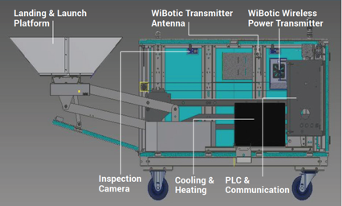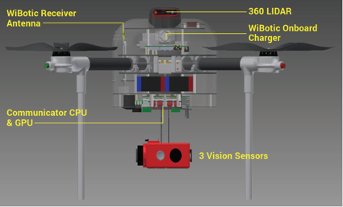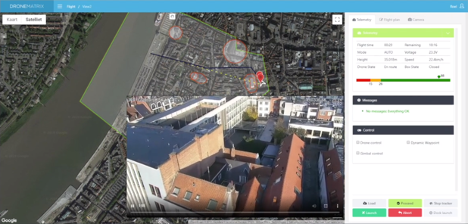CHALLENGE
DroneMatrix is a European drone manufacturer that specializes in surveillance, security, and inspection and works with organizations that need on-demand drone operations in harsh environments.
They manufacture the YACOB system, a semi-autonomous drone and accompanying docking station. YACOB was recently selected for a pilot project by the Antwerp police and fire department, as a way to enhance security and surveillance measures while reducing helicopter noise. The video below shows some of the advantages YACOB drones provide, including:
- Semi-autonomous functionality: leaving – and returning to – their docking stations automatically.
- Enhanced surveillance: YACOB drones are equipped with three camaras including an infrared camera, a 360° camera and a multispectral camera. The cameras can read license plates and ADR signs on trucks (shown in video).
- Safety and reliability: YACOB drones can land in an emergency with a parachute, and fly on average 25 km / hour at an altitude of 35 meters. They can stay in the air for an average of 20 minutes.
These advantages, and others, brought the YACOB system to the attention of two more of DroneMatrix’s customers, which had requirements for on-demand drone operations in harsh environments. The Singapore Police Coast Guard and a solar energy farm came to DroneMatrix for surveillance and inspection applications in areas that are difficult for humans to access and/or patrol.
The Singapore Police Coast Guard patrol boats inspect ships for migrants, something done quickly and safely with a surveillance drone sent from the port grounds. The customer asked DroneMatrix to meet requirements for reliability in corrosive marine environments and fast on-demand deployments.
SOLUTION
DroneMatrix delivered their YACOB system, which includes a steel enclosure with a retractable funnel shaped landing pad. The landing pad enters and exits the housing assembly on the side rather than on the top, reducing weather-related impacts.
The funnel shaped landing pad enables takeoffs and landings without human intervention. Wireless charging – provided by WiBotic – takes that a step further and autonomously charges the drone once it enters the enclosure. According to DroneMatrix, it’s extremely expensive to provide human staff for repetitive battery swapping between flights; wireless charging is more efficient.

Figure 1: Inside the YACOB station, the WiBotic transmitter circuit is mounted to one of the enclosure walls. The transmitter antenna is mounted vertically in the center of the enclosure, so it aligns with the drone after the tray has been pulled inside.
The solar farm had similar requirements for harsh environments and on-demand operations. It needed the ability to inspect vast solar panel arrays for equipment failures, but also benefit from persistent drone surveillance, which prevents thieves from taking copper and valuable metals from the site. But the wind, dust, and dirt at the farm can impact the drone’s lifespan. YACOB provides a climate proof enclosure. Wireless charging means that drones are always ready to investigate potential trespassers and inspect thousands of solar panels at a moment's notice.
When I spoke with Frank VanWelkenhuyzen, DroneMatrix CEO, he said it’s important that their customers can charge the drones very fast without human intervention, so they are always ready.
“Charging must be done independently and the whole system is completely automated. Wireless charging avoids points of failure such as oxidation and bad contact. The drones are placed in harsh marine and desert environments. It’s important that the charge of the battery is completely wireless.”
Wireless charging is essential for on-demand drone performance in punishing environments. Frank’s team is already pursuing new wireless charging applications for inspecting construction sites, delivering medicine between hospitals, and surveilling urban settings (see dronematrix.eu). One common challenge worldwide is the legal restriction on autonomous flight.

Figure 2: Onboard the drone, the receiver circuit and antenna are fully enclosed inside the vehicle’s electronics bay. The receiver antenna is positioned near the outer plastic wall to align with the transmitter antenna once the drone is inside the YACOB station
“One thing we have underestimated is the legal framework,” Frank told me. “If you want to pilot a drone remotely, you get into a legal framework that is very difficult. But the police and the firefighters have an exception, so this is our first focus. If you’re going to fly to an emergency from a police station rooftop or a fire truck, you need to be sure your drone is always charged and ready to fly. The officers can’t be expected to maintain drone batteries with so many other important tasks to perform, so wireless charging is critical to the overall solution for that market as well.”
















Comments